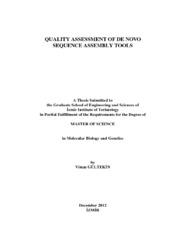Please use this identifier to cite or link to this item:
https://hdl.handle.net/11147/3559Full metadata record
| DC Field | Value | Language |
|---|---|---|
| dc.contributor.advisor | Allmer, Jens | en |
| dc.contributor.author | Gültekin, Visam | - |
| dc.date.accessioned | 2014-07-22T13:51:48Z | - |
| dc.date.available | 2014-07-22T13:51:48Z | - |
| dc.date.issued | 2012 | en |
| dc.identifier.uri | http://hdl.handle.net/11147/3559 | - |
| dc.description | Thesis (Master)--Izmir Institute of Technology, Molecular Biology and Genetics, Izmir, 2012 | en |
| dc.description | Includes bibliographical references (leaves: 47-54) | en |
| dc.description | Text in English; Abstract: Turkish and English | en |
| dc.description | ix, 54 leaves | en |
| dc.description | Full text release delayed at author's request until 2016.01.29 | en |
| dc.description.abstract | High-throughput next generation sequencing technologies progressed very rapidly; revolutionized genomics by providing a robust working field for new studies to be performed and promising the facilitation of the achievements that was extremely challenging before. Although the massive output of these instruments is getting more accurate, still delivers the projection of the real sequence in very short fragments; which necessitates another process of merging and ordering those fragments to reconstruct the larger sequences. This process is performed by sequence assemblers and in the absence of a reference genome; it becomes a de novo sequence assembly. Since assembling millions of fragments in biological aspects have many obvious challenges, there have been many studies specifically focused on developing tools that can adapt to newly announced sequencing technologies, take advantage of the computer science achievements and the technological advancement of computer hardware to the utmost. But these sequence assemblers also need to justify the gain they claim. We took 5 of the commonly used assemblers and assembled two genomic datasets, mined the never mentioned statistics before and commonly used statistics that thought to be the representative of the quality of the assembly. On top of that we also used experimentally validated data that is known to be a part of the organisms’ genome and trailed those in assemblies. | en |
| dc.language.iso | en | en_US |
| dc.publisher | Izmir Institute of Technology | en |
| dc.rights | info:eu-repo/semantics/openAccess | en_US |
| dc.subject.lcsh | Genetics--Technique | en |
| dc.subject.lcsh | Sequence alignment (Bioinformatics) | en |
| dc.title | Quality assessment of de novo sequence assembly tools | en_US |
| dc.type | Master Thesis | en_US |
| dc.institutionauthor | Gültekin, Visam | - |
| dc.department | Thesis (Master)--İzmir Institute of Technology, Molecular Biology and Genetics | en_US |
| dc.relation.publicationcategory | Tez | en_US |
| item.languageiso639-1 | en | - |
| item.fulltext | With Fulltext | - |
| item.openairecristype | http://purl.org/coar/resource_type/c_18cf | - |
| item.openairetype | Master Thesis | - |
| item.grantfulltext | open | - |
| item.cerifentitytype | Publications | - |
| Appears in Collections: | Master Degree / Yüksek Lisans Tezleri | |
Files in This Item:
| File | Description | Size | Format | |
|---|---|---|---|---|
| 458340.pdf | MasterThesis | 2.06 MB | Adobe PDF |  View/Open |
CORE Recommender
Page view(s)
128
checked on Jul 22, 2024
Download(s)
96
checked on Jul 22, 2024
Google ScholarTM
Check
Items in GCRIS Repository are protected by copyright, with all rights reserved, unless otherwise indicated.